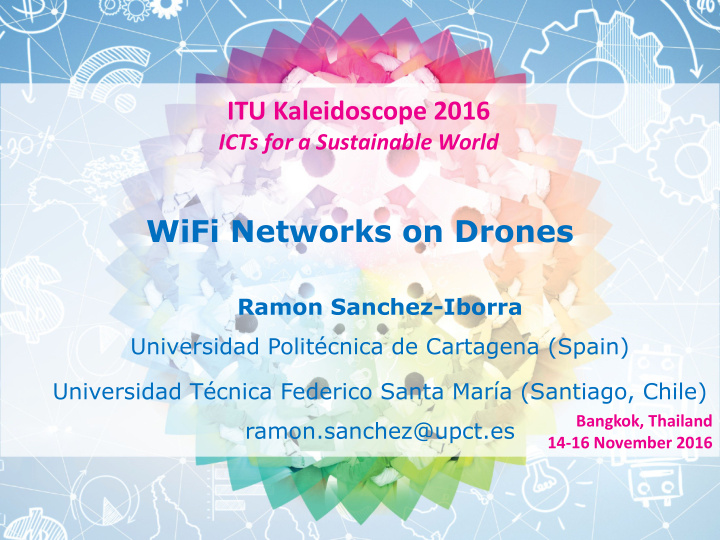



ITU Kaleidoscope 2016 ICTs for a Sustainable World WiFi Networks on Drones Ramon Sanchez-Iborra Universidad Politécnica de Cartagena (Spain) Universidad Técnica Federico Santa María (Santiago, Chile) Bangkok, Thailand ramon.sanchez@upct.es 14-16 November 2016
contents 1. Introduction 2. Aerial networks 3. Test-bench 4. Results 5. Conclusion The 8th ITU Kaleidoscope Academic Conference: ICTs for a Sustainable World 14 - 16 November, Bangkok, Thailand
1 Introduction The 8th ITU Kaleidoscope Academic Conference: ICTs for a Sustainable World 14 - 16 November, Bangkok, Thailand
Introduction 1.1. Motivation • Internet of Things development • Huge number of connected devices • Support or back-up infrastructures to provide constant connectivity 4 The 8th ITU Kaleidoscope Academic Conference: ICTs for a Sustainable World 14 - 16 November, Bangkok, Thailand
Introduction 1.2. Aims and development stages Aims: • Main objective: aerial WiFi network deployment (802.11n) • Sustainable and cheap components: Intel Galileo development board + UAV (drone) Development stages: • Theoretical coverage study • Communication capabilities evaluation • Energy efficiency • Real deployment The 8th ITU Kaleidoscope Academic Conference: ICTs for a Sustainable World 14 - 16 November, Bangkok, Thailand
2 Aerial Networks The 8th ITU Kaleidoscope Academic Conference: ICTs for a Sustainable World 14 - 16 November, Bangkok, Thailand
Aerial Networks 2.1. UAV - FANETS UAV (Unmanned Aerial Vehicle): • Multiple purposes during last times: surveillance tasks, traffic control, catastrophic event monitoring, etc. • Telecommunication field: deployment of aerial networks to increase/improve the connectivity capabilities of current networks or deployment of temporary ones (highly-crowded events, tactical networks …) FANETs (Flying Ad-hoc NETworks): • WiFi, most extended network-access technology • Different 802.11 functioning modes: infrastructure (Access Point) vs. ad-hoc The 8th ITU Kaleidoscope Academic Conference: ICTs for a Sustainable World 14 - 16 November, Bangkok, Thailand
Aerial Networks 2.1. UAV - FANETS FANETS: • Infrastructure mode: conventional WiFi routers • Ad-hoc mode: mesh-networks, sensors, Mobile Ad-hoc NETworks The 8th ITU Kaleidoscope Academic Conference: ICTs for a Sustainable World 14 - 16 November, Bangkok, Thailand
Aerial Networks 2.1. UAV - FANETS FANETS: Features: • Great mobility among network nodes (2D and 3D) • Extremely changing topology • Highly effective routing protocols • Efficient algorithms for saving energy The 8th ITU Kaleidoscope Academic Conference: ICTs for a Sustainable World 14 - 16 November, Bangkok, Thailand
3 Test-benches The 8th ITU Kaleidoscope Academic Conference: ICTs for a Sustainable World 14 - 16 November, Bangkok, Thailand
Test-benches 3.1. Equipment Intel Galileo: • Focused on IoT application development • Different connectivity possibilities and low power consumption Idea-Fly IFLY-4S: • Great performance and efficiency • Up to 15 min. flying The 8th ITU Kaleidoscope Academic Conference: ICTs for a Sustainable World 14 - 16 November, Bangkok, Thailand
Test-benches 3.2. Test-bench Throughput and signal level: • ‘Iperf3’ tool • Linux ‘ iw ’ command and spectrum analyzer The 8th ITU Kaleidoscope Academic Conference: ICTs for a Sustainable World 14 - 16 November, Bangkok, Thailand
Test-benches 3.2. Test-bench Power consumption: • Demanded current by the board • 30 s CBR transmissions at different rates • Intel Galileo performing as: router (infrastructure mode) and intermediate hop (ad-hoc mode) The 8th ITU Kaleidoscope Academic Conference: ICTs for a Sustainable World 14 - 16 November, Bangkok, Thailand
4 Results The 8th ITU Kaleidoscope Academic Conference: ICTs for a Sustainable World 14 - 16 November, Bangkok, Thailand
Results 4.1. Throughput (lab conditions) • Galileo board acting as an intermediate node Operational mode Packet size (Bytes) Max. Throughput (Mbps) 512 10.5 AP 1024 11 512 4.5 Ad-hoc 1024 7.5 The 8th ITU Kaleidoscope Academic Conference: ICTs for a Sustainable World 14 - 16 November, Bangkok, Thailand
Results 4.2. Energy consumption (lab conditions) Idle Transmisión Idle (a) Infrastructure mode. Packet size: 512 B. (b) Ad-hoc mode. Packet size: 512 B. (c) Infrastructure mode. Packet size: 1024 B. (d) Ad-hoc mode. Packet size: 1024 B. Current consumption (mA) for both modes of operation and different CBR rates The 8th ITU Kaleidoscope Academic Conference: ICTs for a Sustainable World 14 - 16 November, Bangkok, Thailand
Results 4.3. Coverage range (real experiment) (a) Infrastructure mode (10 m) (b) Ad-hoc mode (10 m) (c) Infrastructure mode (20 m) (d) Ad-hoc mode (20 m) Signal level (dBm) for both modes of operation at a drone height of 10 m (a and b) and 20 m (c and d) The 8th ITU Kaleidoscope Academic Conference: ICTs for a Sustainable World 14 - 16 November, Bangkok, Thailand
Results 4.4. Throughput (real experiment) (a) Infrastructure mode (10 m) (b) Ad-hoc mode (10 m) (c) Infrastructure mode (20 m) (d) Ad-hoc mode (20 m) Average throughput (MBps) for both modes of operation at a drone height of 10 m (a and b) and 20 m (c and d) The 8th ITU Kaleidoscope Academic Conference: ICTs for a Sustainable World 14 - 16 November, Bangkok, Thailand
Results 4.5. Impact of antenna configuration Radiation patterns for different antenna configuration The 8th ITU Kaleidoscope Academic Conference: ICTs for a Sustainable World 14 - 16 November, Bangkok, Thailand
5 Conclusion The 8th ITU Kaleidoscope Academic Conference: ICTs for a Sustainable World 14 - 16 November, Bangkok, Thailand
Conclusion 5.1. Conclusion and future work • Trade-off between infrastructure (AP) and ad-hoc modes: - AP provides greater signal level and throughput - Ad-hoc provides better energy efficiency • Real experiments are severely impacted by enviromental conditions, drone unstability and antenna configuration: additional tests are required • Future work: multiple nodes (FANETS). Mixed configurations: AP mode for users ’ connectivity and ad-hoc for routing traffic, considering the newest versions of the WiFi standard (e.g., 802.11ac) The 8th ITU Kaleidoscope Academic Conference: ICTs for a Sustainable World 14 - 16 November, Bangkok, Thailand
THANKS FOR YOUR ATTENTION WiFi Networks on Drones Antonio Guillen-Perez Ramon Sanchez-Iborra Maria-Dolores Cano Juan Carlos Sanchez-Aarnoutse Joan Garcia-Haro The 8 th ITU Kaleidoscope Academic Conference: ICTs for a Sustainable World 14 - 16 November, Bangkok, Thailand
Recommend
More recommend